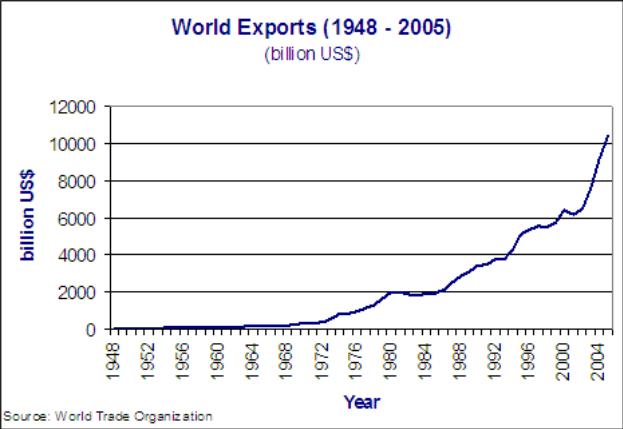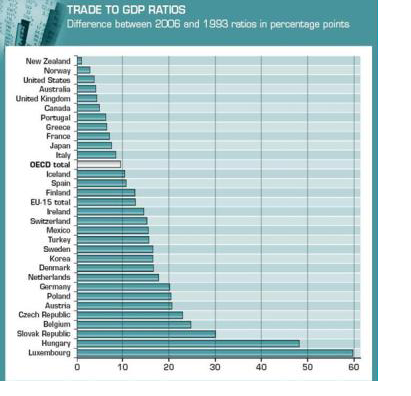
- •Introduction
- •General thoeritical aspects of international trade
- •1.1 History of International Trade
- •1.2 International Trade Theory
- •1.3 International Trade Models
- •1.4 Advantages of International Trade
- •Analytical aspects of international trade
- •New trends in International Trade
- •World Trade by regions
- •2.3 Risk In International Trade
Analytical aspects of international trade
New trends in International Trade
International trade is increasingly recognized as a vital engine for economic development . Trade, development and poverty are linked in multiple ways. The same set of policies produces dramatically different results in different countries. The outcome is affected by physical and geographical characteristics of the countries; the nature of the implementation of the policy measures the capacity and quality of institutions under which the reforms are implemented and a country’s political and social environment.
One simple way to see this is to look at the growth of exports in the world during the past 50+ years. The following figure shows overall annual exports measured in billions of US dollars from 1948 to 2005. Recognizing that one country's exports are another country's imports, one can see the exponential growth in trade during the past 50 years.

1.Picture. World Exports (1948-2005)
The data collected by world trade organization is great example of role of trade and if we observe the chart so we can conclude that after world war 2 the economy of the world adopted a new shape for itself, since we can see that till 1963 the world export was stable and was too low but after 1964 there was kind of nudge in the worlds economy that directly influenced the worlds export and increased till the point of 10 thousand billion in 2005 and the slope goes up. The only reason of this increment is the new technologies, innovations, international trade and some other factors that caused the countries to trade more among themselves, definitly this increment doesn’t belongs to devolped countries but also some of fast growing, developing countries such as china, india and brazil etc.[5,4-5]
However, rapid growth in the value of exports does not necessarily indicate that trade is becoming more important. Instead, one needs to look at the share of traded goods in relation to the size of the world economy. The adjoining figure shows world exports as a percentage of world GDP for the years 1970 to 2005. It shows a steady increase in trade as a share of the size of the world economy. World exports grew from just over 10% of GDP in 1970 to almost 30% by 2005. Thus, trade is not only rising rapidly in absolute terms, it is becoming relatively more important too.

2. Picture. Words Export value and Merchandise trade (% of GDP). WTO
If we observe the above chart Global trade has grown both in absolute and relative terms, especially after 1990 where global exports surged in the wake of rapid industrialization in developing countries and the massive offshoring of manufacturing, particularly in China. The value of global exports first exceeded $US 1 trillion in 1977 and by 2008, more than 16 trillion current US dollars of merchandises were exported. During the same time period, the share of the world GDP accounted by merchandise trade, imports and exports combined, surged from 18% to 52%. This trend is correlated with a growth in international transportation, particularly container transport. Yet, this fast growth is skewed by the international division of production where parts can be traded several times before an assembled good is ready for final consumption. This is particularly the case for countries having a high level of economic integration such as NAFTA (Canada, the United States and Mexico), or the European Union.The growth of exports is indicative of a cycle where trade emerged (up the 1980), accelerated (1980-2000) and reached peak growth (2000-2008). This process cannot go on indefinitely as growth in trade was also accompanied by a surge in trade imbalances. Eventually a phase of maturity in global trade may be reached. The financial crisis of 2008-2009 was accompanied by a significant decline of global merchandise trade, close to 25% in just one year. The main factor behind this decline was a drop in the consumption of durable goods (e.g. furniture, appliances, cars) since consumers are able to postpone these type of purchases if they are uncertain about the future. Growth resumed afterwards, mainly driven by emerging economies.[7]
Global trade grew from around the equivalent of 40% of world GDP in 1992 to over 50% today. At the same time, the share of world trade of OECD countries dropped from 73% to 64%.
Trade affects practically everything we buy at some stage, and influences many aspects of our daily lives. Whether this influence is good or bad depends on how you look at things. Cheap products may be good for the consumer, but what about the people who make and sell them?
There are no simple answers to many of the questions raised by international trade. Trade can be a powerful force for positive developments, but it can also bring problems and uncertainties. It may not be the most important factor determining the prosperity of countries and people, but lasting prosperity is unlikely without it.

3.picture. Trade to GDP ratios prepared by OECD
A convenient way to measure the importance of international trade is to calculate the share of trade in GDP. If we have a look to this chart so we can know that to which ratio is the contribution of trade in the GDP of some developed and developing countries hence we can say that Luxemborg, Hungry, Slovak, Belgium and some other countries has truely got the benefit of trade influencing in their GDP. The reason that these countries has benefited more is that International trade tends to be more important for countries that are small (in terms of geographic size or population) and surrounded by neighbouring countries with open trade tegimes than for large, relatively self-sufficient countries or those that are geographically isolatedand thus penalised by high transport costs. Other factor also play a role and help explain differences in tradee-to-GDP ratios across countries. These include history, culture, trade policy, the structure of the economy and the presence of multinational firms.
Evidence from the older industrialised economies and newer emerging ones bears this out. Trade must therefore be an important component in any overall economic strategy that aims to generate sustained growth and prosperity.[3,2]
Trade can bring benefits through making available a larger number of goods, at lower prices, to a greater number of people. But larger, lower or greater than what? A modern economy without trade doesn’t exist, so the comparison is difficult to make but try to imagine a situation where the only goods or services you had available were the ones you provided yourself.
The opening of markets has boosted trade and economic growth worldwide in the past few decades. Yet tariffs – taxes imposed by importing countries on foreign goods remain a key obstacle to market access. The OECD estimates that scrapping all tariffs on merchandise trade and reducing trade costs by 1% of the value of trade worldwide would boost global welfare by more than $170 billion dollars a year, in some areas adding the equivalent of up to 2% to GDP. Conservative estimates suggest there would be significant welfare gains for developing and developed countries alike. Under many scenarios, developing countries as a group could expect greater gains than the developed countries.
The growth of international trade and investment has been stimulated partly by the steady decline of trade barriers since the Great Depression of the 1930s. In the post World War II era the General Agreement on Tariffs and Trade, or GATT, was an agreement that prompted regular negotiations among a growing body of members to reduce tariffs (import taxes) on imported goods on a reciprocal basis. During each of these regular negotiations, (eight of these rounds were completed between 1948 and
1994), countries promised to reduce their tariffs on imports in exchange for
concessions, or tariffs reductions, by other GATT members. When the most recent completed round was finished in 1994, the member countries succeeded in extending the agreement to include liberalization promises in a much larger sphere of influence. Now countries would not only lower tariffs on goods trade, but would begin to liberalize agriculture and services market. They would eliminate the many quota systems - like the multi-fiber agreement in clothing - that had sprouted up in previous decades. And they would agree to adhere to certain minimum standards to protect intellectual property rights such as patents, trademarks and copyrights. [3,3-5]
